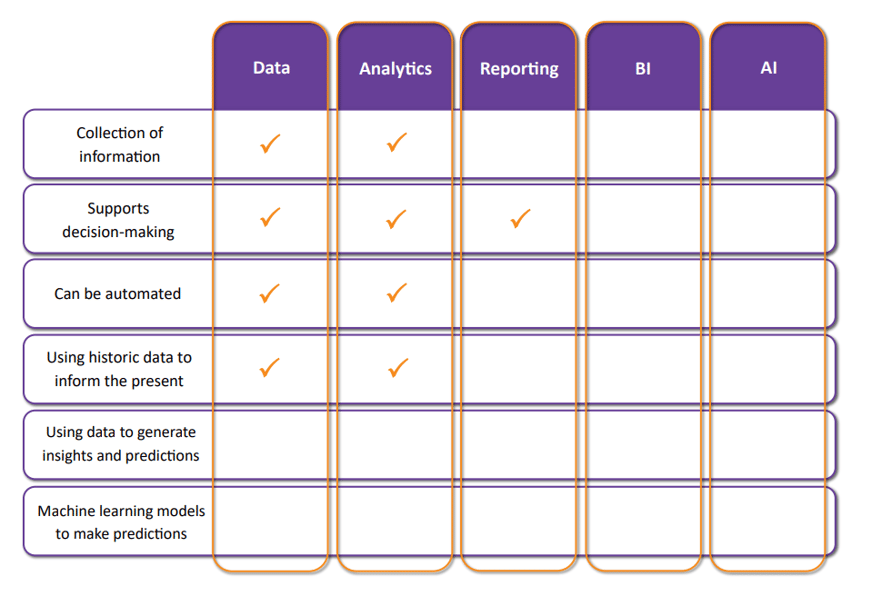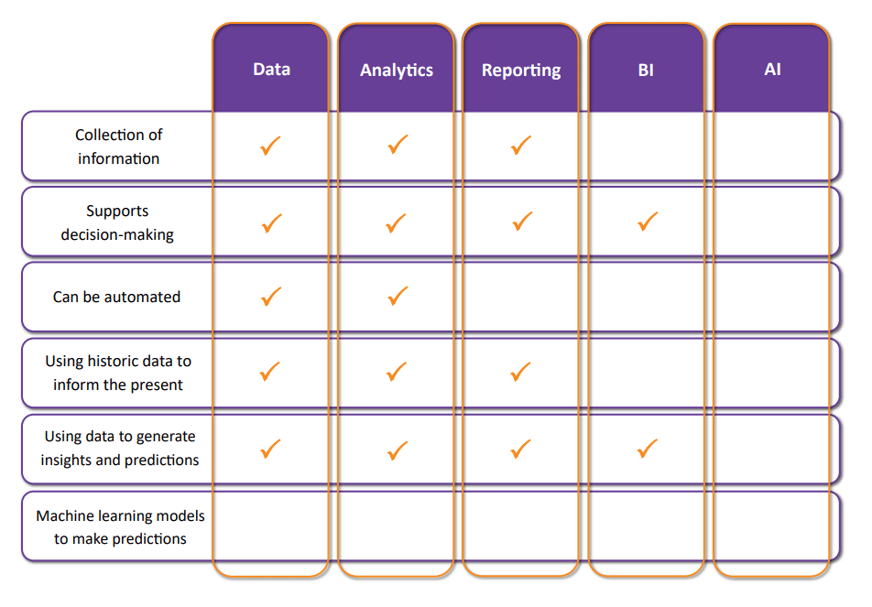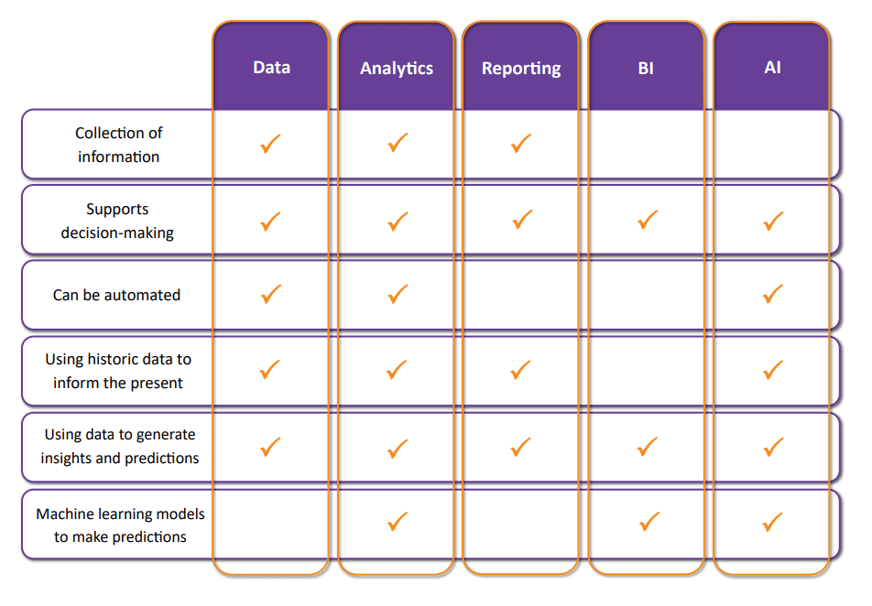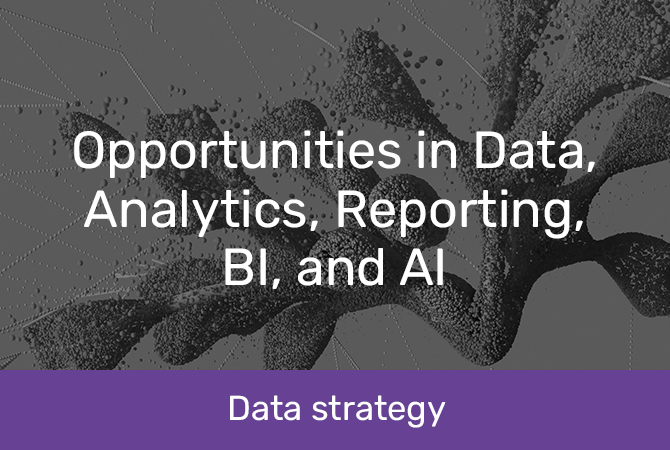
Opportunities in Data, Analytics, Reporting, BI, and AI
Overlaps and our predictions
The fields of data, analytics, reporting, business intelligence (BI), and artificial intelligence (AI) are moving fast. As you continue navigating the complexities of the digital age, it’s more important than ever to equip yourself with an understanding of the intersections and overlaps.
In the article we released last month on this topic, we explored the definitions and gave high-level predictions for data, analytics, reporting, BI, and AI in 2024.
Now, let’s examine the intersections between these domains and identify the ripest opportunities for businesses to benefit from them in the coming year.
 definitions recap
definitions recap
Here’s a quick reminder of what we mean when we talk about data, analytics, reporting, BI, and AI.
- Data refers to the figures, statistics, values, and raw facts used for analysis, insights, and decision-making.
- Analytics is a science that translates raw data into findings and insights.
- Reporting for businesses is all about compiling and reviewing information to answer specific questions.
- Business intelligence uses data to visualise business performance and help identify strengths and weaknesses.
- Artificial intelligence uses a combination of datasets and computer science to perform tasks that typically require human intelligence.
We went deeper into these definitions in this article – Data, Analytics, Reporting, BI, and AI in 2024.
 Datamine's predictions for 2024
Datamine's predictions for 2024
In January, we predicted that advancements in AI, machine learning, and automation would significantly affect the evolution of analytics, reporting, and BI this year. And already, we are starting to see our predictions play out.
We’ve noticed a widespread curiosity among people engaging with our industry around the subject of AI. Its widespread adoption has led many organisations to view it as essential, even if they don’t yet know how to use AI.
It’s important to remember that the AI we are seeing is just an extension of what has been happening in the automation and machine learning field for years: good algorithms. The critical difference is that AI has now entered the mainstream, and implementing AI at an entry-level (for instance, with chatbots) makes sense for many businesses and is quick and easy to implement.
Datamine sees a split between businesses prioritising innovation and businesses that need to focus on adapting to inflation.
That means, depending on your business priorities this year, how you apply automation might look different from what your peers are doing.
Automation is usually the first step towards AI – so whether or not you are ready to take on AI this year, starting a data automation project will equip your business for an AI journey in the future. By taking over manual processes, automation frees up time for your teams to focus on other tasks. If your business is looking ahead at new innovations, that could be a good opportunity to try out some form of AI integration or refinement.
However, the cost-of-living crisis has a long tail. Many companies are still struggling, meaning AI is not yet a priority. It brings business intelligence, analytics, and reporting to the forefront, as these initiatives all reveal critical areas for organisations to focus on as they come out the other side of challenging economic conditions.
That means 2024 will likely be a back-to-basics year for a lot of organisations. Automation enters the picture here if you need to save time on the business-as-usual and take more time knuckling down on the areas that matter most to your business. If you need to take this year to stay afloat during the cost-of-living crisis, automation is a great tool to help strengthen your business now and set you up for future growth.
 Areas of overlap - Summarised
Areas of overlap - Summarised
Every business has a unique relationship with its data, and there is no one-size-fits-all way to take advantage of it. Datamine has been working in this space for almost three decades – over that time, we have spotted some patterns. The charts below summarise states from beginner to advanced, so you can benchmark your business and set priorities for future data strategy and business planning.
Beginner:
Organisations at the beginner stage of analytics projects often have a collection of data waiting to be used. Decision-making support is low level.
![]()
Intermediate:
A business that uses its data at an intermediate level may have an implementation chart that looks like this. While an intermediate-stage business might not yet leverage BI and AI, bringing in automation at this early stage is a great way to enable future scalability in the data strategy project.

Advanced:
The table below exemplifies what we would describe as a more advanced use of these technologies. Note that there is some automation and BI, but nothing corresponding to AI or machine learning has yet been ticked.

Future state - What we expect "Advanced" to look like:
Here, Datamine speculates on what the most likely next steps will be for an organisation far enough along in its data and analytics journey to step into using AI and machine learning.

 Overlaps and opportunities
Overlaps and opportunities
As seen in the tables above, data, analytics, reporting, BI, and AI are interconnected components that generate insights and drive informed decision-making within an organisation.
By understanding the key ways these elements connect and relate, you can specify better use cases and priorities for using data in your business.
Reliance on integrated data
Data integration, which refers to the process of combining data from various sources into a unified view, is fundamental to both analytics and BI. Analytics relies on integrated datasets to uncover patterns and trends, while many BI tools use integrated data to generate reports and dashboards that provide a holistic view of business performance.
Analytics informs BI, which informs reporting
Advanced analytics techniques, such as predictive and prescriptive analytics, enhance the insights derived from BI. Analytics can uncover deeper patterns that go beyond traditional reporting.
Key performance indicators (KPIs) and metrics identified through analytics and BI often become the focal points of regular reports and dashboards. These reports ensure that decision-makers stay informed about critical aspects of business performance, which is fundamental to what we do at Datamine.
Data quality assurance for analytics and BI
Analytics, BI, and AI are only as good as their data quality.
Poor data quality can lead to inaccurate insights, which presents major risks to your business – like lost revenue, missed competitive advantage opportunities, and dissatisfied customers. Quality assurance processes and tools support you to clean, validate, and ultimately ensure the integrity of your data. Good data means you can trust your results - your data-driven projects meet your standards and deliver actionable results.
AI-powered...
Analytics
AI algorithms play a role in advanced analytics by automating complex pattern recognition, anomaly detection, and predictive modelling. While not every analytics task can be automated, this greatly enhances their efficiency – freeing up time for you to uncover deeper insights and scale your analytics operations.
BI
Integrating AI into BI tools enables the automation of tasks such as data preparation, report generation, and anomaly detection. Reducing the manual effort typically required in these tasks streamlines processes and helps your teams avoid getting stuck in BAU with no time to progress new projects.
AI also presents the opportunity for more personalisation in your BI systems. Done well, you can offer tailored recommendations and insights based on your customers’ specific roles, preferences, and historical interactions with your platform.
Generating feedback loops
When setting up your data-driven projects to run on a continuous feedback loop, all the data, analytics, reporting, BI, and/or AI improve concurrently. For example, you might gain insights from analytics and AI, which you can use to inform and improve reporting formats.
Responsible AI and ethical data usage
As we grow more accustomed to AI in the mainstream, Datamine is seeing a greater understanding and awareness of practices surrounding responsible AI, ethics in data usage, and the importance of avoiding bias in AI models. Because of this growing awareness, it is advantageous for people who use AI to seek ways of prioritising fairness, transparency, and accountability in AI and analytics processes.
 Equipping your business with data analytics
Equipping your business with data analytics
The convergence of data, reporting, analytics, business intelligence, and artificial intelligence presents a wealth of opportunities for businesses seeking to thrive in today's data-driven landscape. By leveraging automation technologies across these domains, you can streamline operations, uncover valuable insights, and make decisions more efficiently and accurately.
2024 is well underway. Take the time now to consider how your data strategies will set you up for success. Datamine is an expert at guiding clients towards improved data analytics. To learn more, here’s what we recommend reading next:
Subscribe to Datafix
Do you want to go beyond guesswork to implement smart, data-driven business strategies? Then, don't miss our monthly Datafix newsletter. Fill out the form below to subscribe.


















































